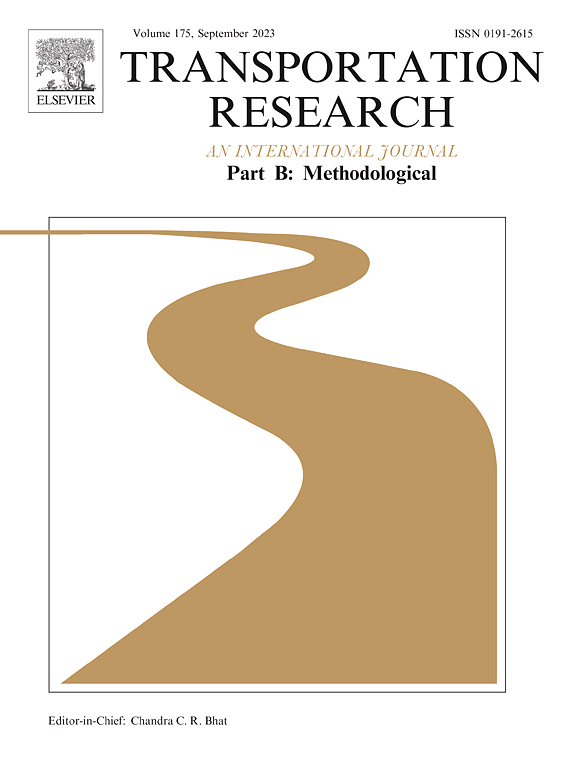Dynamic spatial price equilibrium, dynamic user equilibrium, and freight transportation in continuous time: A differential variational inequality perspective
IF 5.8
1区 工程技术
Q1 ECONOMICS
引用次数: 0
Abstract
In this paper we provide a statement of dynamic spatial price equilibrium (DSPE) in continuous time as a basis for modeling freight flows in a network economy. The model presented describes a spatial price equilibrium due to its reliance on the notion that freight movements occur in response to differences between the local and distant prices of goods for which there is excess demand; moreover, local and distant delivered prices are equated at equilibrium. We propose and analyze a differential variational inequality (DVI) associated with dynamic spatial price equilibrium to study the Nash-like aggregate game at the heart of DSPE using the calculus of variations and optimal control theory. Our formulation explicitly considers inventory and the time lag between shipping and demand fulfillment. We stress that such a time lag cannot be readily accommodated in a discrete-time formulation. We provide an in-depth analysis of the DVI's necessary conditions that reveals the dynamic user equilibrium nature of freight flows obtained from the DVI, alongside the role played by freight transport in maintaining equilibrium commodity prices and the delivered-price-equals-local-price property of spatial price equilibrium. By intent, our contribution is wholly theoretical in nature, focusing on a mathematical statement of the defining equations and inequalities for dynamic spatial price equilibrium (DSPE), while also showing there is an associated differential variational inequality (DVI), any solution of which is a DSPE. The model of spatial price equilibrium we present integrates the theory of spatial price equilibrium in a dynamic setting with the path delay operator notion used in the theory of dynamic user equilibrium. It should be noted that the path delay operator used herein is based on LWR theory and fully vetted in the published dynamic user equilibrium literature. This integration is new and constitutes a significant addition to the spatial price equilibrium and freight network equilibrium modeling literatures. Among other things, it points the way for researchers interested in dynamic traffic assignment to become involved in dynamic freight modeling using the technical knowledge they already possess. In particular, it suggests that algorithms developed for dynamic user equilibrium may be adapted to the study of urban freight modelled as a dynamic spatial price equilibrium. As such, our work provides direction for future DSPE algorithmic research and application. However, no computational experiments are reported herein; instead, the computing of dynamic spatial price equilibria is the subject of a separate manuscript.
动态空间价格均衡、动态用户均衡和连续时间货运:微分变分不等式视角
在本文中,我们提供了一个连续时间动态空间价格均衡(DSPE)的陈述,作为网络经济中货运建模的基础。本文提出的模型描述了一种空间价格均衡,因为它依赖于这样一个概念,即货运流动是对存在过剩需求的商品的本地和远距离价格差异的反应;此外,本地和远距离交货价格在均衡时是相等的。我们提出并分析了与动态空间价格均衡相关的微分变分不等式(DVI),利用变分微积分和最优控制理论来研究 DSPE 核心的纳什式总量博弈。我们的公式明确考虑了库存以及运输和需求满足之间的时滞。我们强调,这种时滞无法在离散时间公式中轻易解决。我们对 DVI 的必要条件进行了深入分析,揭示了从 DVI 中获得的货运流量的动态用户均衡性质,以及货运在维持商品均衡价格和空间价格均衡的交付价格等于本地价格属性中所发挥的作用。从本意上讲,我们的贡献完全是理论性的,侧重于动态空间价格均衡(DSPE)定义方程和不等式的数学表述,同时还表明存在相关的微分变分不等式(DVI),其任何解都是 DSPE。我们提出的空间价格均衡模型将动态环境下的空间价格均衡理论与动态用户均衡理论中使用的路径延迟算子概念相结合。需要指出的是,这里使用的路径延迟算子是基于 LWR 理论,并在已发表的动态用户均衡文献中得到了充分验证。这种整合是全新的,是对空间价格均衡和货运网络均衡建模文献的重要补充。除其他外,它为对动态交通分配感兴趣的研究人员指明了方向,使他们可以利用已有的技术知识参与动态货运建模。特别是,它表明为动态用户均衡开发的算法可适用于以动态空间价格均衡为模型的城市货运研究。因此,我们的工作为未来的 DSPE 算法研究和应用提供了方向。不过,本文没有报告计算实验;相反,动态空间价格均衡的计算是另一篇手稿的主题。
本文章由计算机程序翻译,如有差异,请以英文原文为准。
求助全文
约1分钟内获得全文
求助全文
来源期刊
CiteScore
12.40
自引率
8.80%
发文量
143
审稿时长
14.1 weeks
期刊介绍:
Transportation Research: Part B publishes papers on all methodological aspects of the subject, particularly those that require mathematical analysis. The general theme of the journal is the development and solution of problems that are adequately motivated to deal with important aspects of the design and/or analysis of transportation systems. Areas covered include: traffic flow; design and analysis of transportation networks; control and scheduling; optimization; queuing theory; logistics; supply chains; development and application of statistical, econometric and mathematical models to address transportation problems; cost models; pricing and/or investment; traveler or shipper behavior; cost-benefit methodologies.

 求助内容:
求助内容: 应助结果提醒方式:
应助结果提醒方式:


